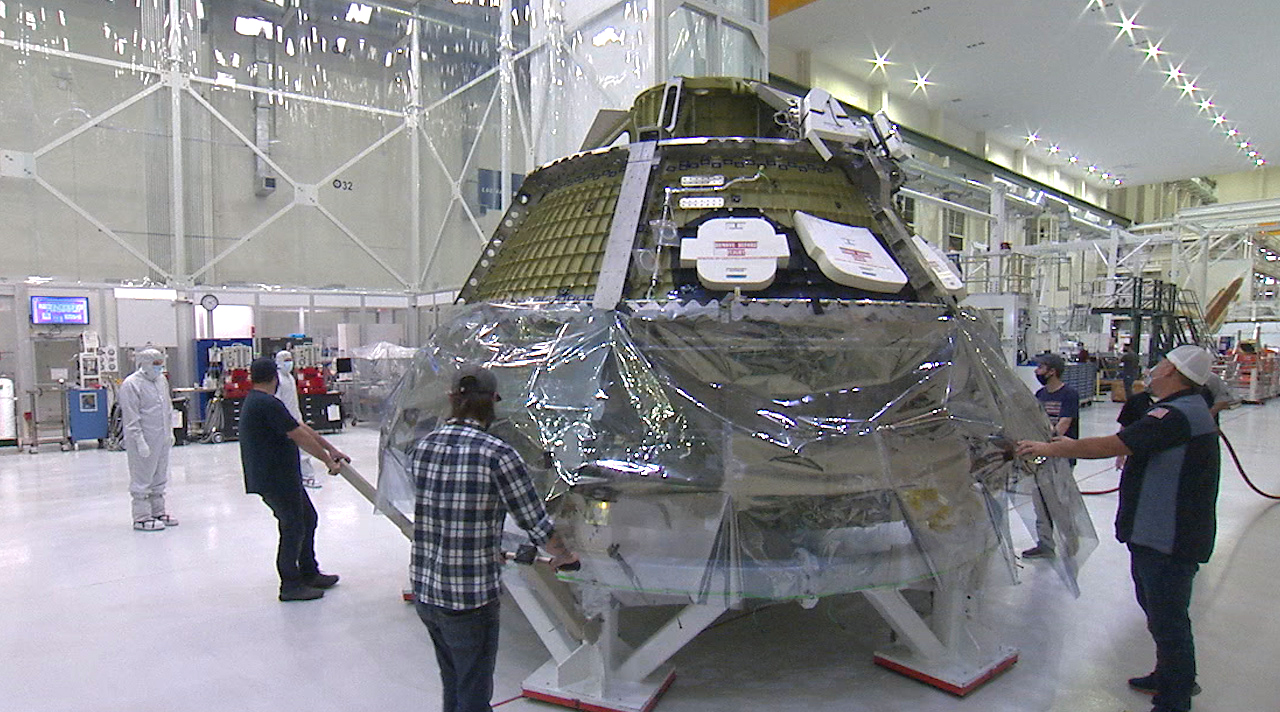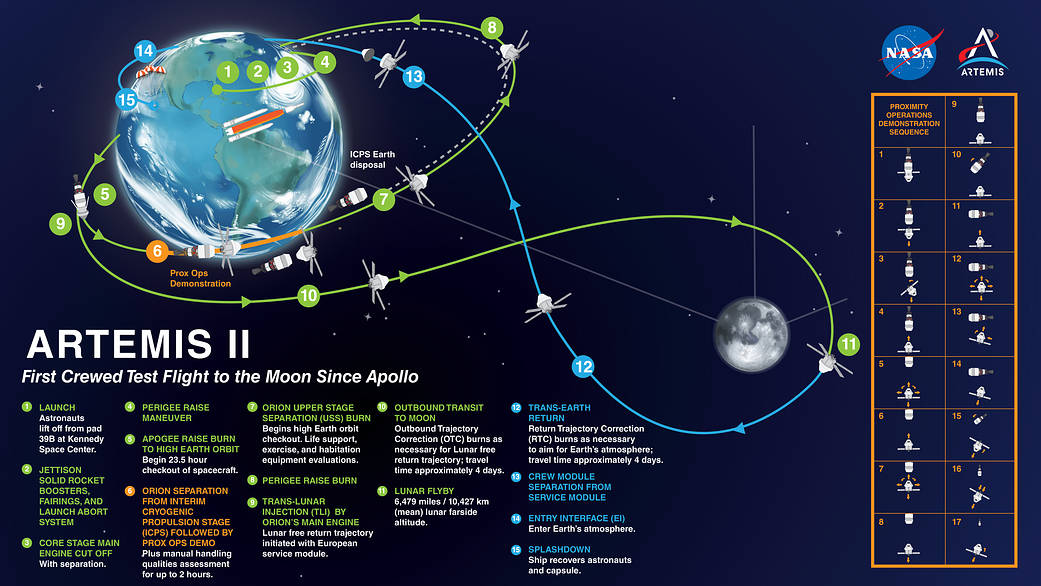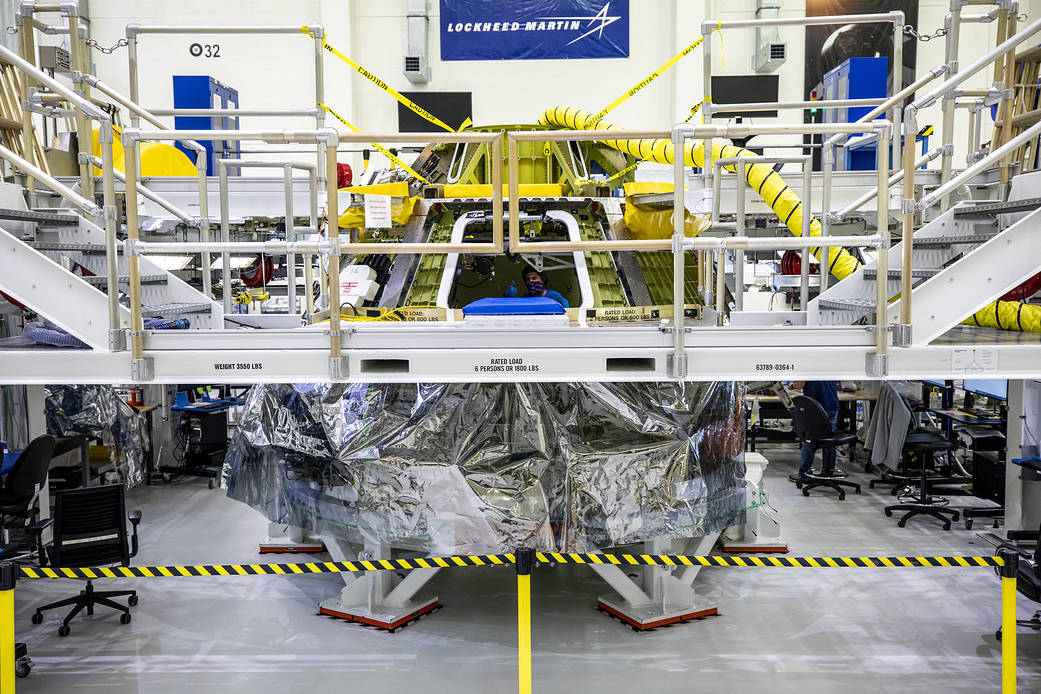Artemis II

Artemis II is the first Space Launch System (SLS) and Orion flight with astronauts. With confidence based on the Artemis I mission and the thousands of hours put into the prior flight and testing, this mission will send astronauts on an approximately 10-day mission where they will set a record for the farthest human travel beyond the far side of the Moon.
The mission will launch a crew of four astronauts from Kennedy on a Block 1 configuration of the SLS rocket. The flight profile is called a hybrid free return trajectory. Orion will perform multiple maneuvers to raise its orbit around Earth and eventually place the crew on a lunar free return trajectory in which Earth’s gravity will naturally pull Orion back home after flying around the Moon.
The initial launch will be similar to Artemis I as SLS lofts Orion into space and then jettisons the boosters, service module panels, and launch abort system, before the core stage engines shut down and the core stage separates from the upper stage and the spacecraft. With crew aboard this mission, Orion and the upper stage, called the interim cryogenic propulsion stage (ICPS), will then orbit Earth twice to ensure Orion’s systems are working as expected while still close to home.
The spacecraft will first reach an initial orbit flying in the shape of an ellipse, at a low altitude (perigee) of about 115 miles by a high altitude (apogee) of 1,800 miles. The orbit will last a little over 90 minutes and include an initial firing of the ICPS to maintain Orion’s path. After the first orbit, the ICPS will raise Orion to a high-Earth orbit. This maneuver will enable the spacecraft to build up enough speed for the eventual push toward the Moon. The second, larger orbit will take approximately 42 hours, with Orion flying in an ellipse between about 235 and 68,000 miles above Earth.

After the burn to enter high-Earth orbit, Orion will separate from the ICPS. The expended stage will have one final use before disposal through Earth’s atmosphere—the crew will use it as a target for a proximity operations demonstration. During the demonstration, mission controllers in Houston will monitor Orion as the astronauts transition the spacecraft to manual mode and pilot Orion’s flight path and orientation. The crew will use Orion’s onboard cameras and the view from the spacecraft’s windows to line up with the ICPS as they approach and back away from the stage to assess Orion’s handling qualities and related hardware and software. This demonstration will provide performance data and operational experience that cannot be readily gained on the ground in preparation for critical rendezvous, proximity operations, and docking, as well as undocking operations in lunar orbit beginning on Artemis III.
Following the proximity operations demonstration, the crew will turn control of Orion back to mission controllers at Johnson and spend the remainder of the orbit verifying spacecraft system performance in the space environment.
While still close to Earth, the crew will assess the performance of the life support system’s capabilities and ensure readiness for the lunar flyby portion of the mission. Orion will also briefly fly beyond the range of GPS satellites and the Tracking and Data Relay Satellites of NASA’s Near Space Network to allow an early checkout of the agency’s Deep Space Network communication and navigation capabilities.
After completing checkout procedures, Orion will perform the next propulsion move called the trans-lunar injection (TLI) burn. With the ICPS having done most of the work to put Orion into a high-Earth orbit, the service module’s main engine will fire to perform the TLI burn that will propel Orion on a path toward the Moon. The TLI burn will send crew on an outbound trip of about four days to lunar orbit, with the service module performing orbit correction burns as needed along the way. The crew will travel 40,000 miles around the far side of the Moon, where they will ultimately create a figure eight extending about 280,000 miles from Earth before Orion returns home.
On the remainder of the trip, astronauts will continue to evaluate the spacecraft’s systems, including demonstrating return operations, practicing emergency procedures, and testing the radiation shelter, among other activities.
With a return trip of about four days, the mission is expected to last just over 10 days. Instead of requiring propulsion on the return, the fuel-efficient free return trajectory harnesses the Earth-Moon gravity field, ensuring that—after its trip around the far side of the Moon—Orion will be pulled back naturally by Earth’s gravity for the remaining portion of the mission.
During Orion’s return to Earth, the crew module separates from the service module and begins entry, traveling nearly 25,000 mph. A series of drogue and pilot parachutes will slow Orion down from Mach 32 to zero in approximately 20 minutes, ending a mission that will exceed 620,000 miles. Recovery forces, already positioned at the target landing zone, will be ready to recover the crew from the Pacific Ocean.
| Launch Site | Kennedy Space Center, Florida, Launch Pad 39B |
| Launch Vehicle | Space Launch System Block 1 |
| Orion Gross Liftoff Weight | 78,000 lbs. |
| Trans-Lunar Injection Mass | 58,500 lbs. |
| Post-Trans Lunar Injection Mass | 57,500 lbs. |

























